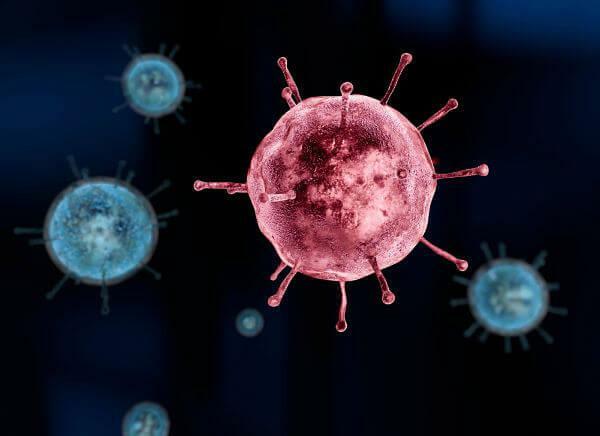Youvirusthey are small and quite simple organisms that are considered living beings by some authors and not living beings by others. To get an idea of the size of these organisms, the smallest virus on record is only 20 nm in diameter, and therefore smaller than a ribosome. Viruses are mainly known to cause various diseases and are considered to be obligate intracellular parasites.
Read too: What is a living being?
→ Virus structure
Viruses are organisms that do not have cells (acellular), and their structure is basically formed by proteins and nucleic acid. The protein forms an envelope called capsidium, which is formed by several capsomeres and can be used as a way to classify viruses. According to viral symmetry, we can classify them into icosahedral, helical and complex.
The main function of capsids is to protect the genetic material, which is usually only one type (DNA or RNA), although some viruses have both types (cytomegalovirus). Unlike most living beings, the genome of viruses is quite differentiated, existing organisms with double-stranded DNA, single-stranded DNA, double-stranded RNA or single-stranded RNA. Regardless of the type of genetic material observed, the genome is usually organized as a single linear or circular molecule.

Look at the basic structure of a virus.
Some viruses even have a envelope located outside the capsid and made up of lipids, proteins and carbohydrates. This structure derives from the parasitized cell's membrane system and is acquired when the virus is eliminated by the budding process. Viruses that have an envelope are called envelopes.
Do not stop now... There's more after the advertising ;)
Therefore, in a nutshell, we can say that viruses are composed of:
nucleic acid (DNA, RNA or both);
capsid;
membranous envelope (only present in some types of virus).
→ Are viruses alive?
Viruses are acellular organisms and, despite not having a cell, they are extremely dependent on these structures, since they do not have their own metabolism and do not have any organelle. By parasitizing a cell, they induce the production of viral genetic material and proteins, controlling cell metabolism. In view of this characteristic, the viruses are called obligate intracellular parasites.

Bacteriophage virus is a virus that parasitizes only bacterial cells.
As they do not have metabolism outside a cell, many authors do not admit that they are considered living beings. Other researchers, on the other hand, consider them alive because they can duplicate and display genetic variability. Another point that contributes to this last classification is the presence of molecules such as proteins, lipids and carbohydrates.
Mind Map: Virus

* To download the mind map in PDF, Click here!
→ Virus reproduction
Viruses, as we know, can only reproduce in host cells, as they lack the enzymes and structures necessary for the production of proteins. Thus, we can say that when viruses are in the environment without parasitizing any cell, they function only as a structure that contains genes.
Viruses reproduce in a variety of ways, but generally go through a few basic steps:
→ Adsorption: there is an interaction between the cell that will be parasitized and the viruses, forming links between the invading beings and the receptors in the cell membrane.
→ Penetration: all or part of the virus enters the cell.
→ Baring: the virus's nucleic acid is released into the cell, separating from its capsid.
→ Biosynthesis: the genetic material is duplicated and the necessary proteins to form the capsid are synthesized.
→ Morphogenesis: the organization of the structures that form the capsid and the genetic material takes place.
→ Release: cell lysis and virus release occurs. In the case of envelopes, these organisms sprout.
Read too:Reproduction of DNA Viruses
→ Viruses

Viruses can cause illnesses, which are called viruses.
When parasitizing a human cell, viruses can trigger several diseases, which are generically called viruses. These illnesses can be easy to treat, as in the case of a cold, or not curable, as in the case of AIDS. Also, they may or may not cause symptoms in the individual. Examples of viral diseases are dengue, hepatitis, AIDS, anger,varicella,smallpox,rubella,ebola, herpes and the flu. It is noteworthy that each disease has different symptoms and treatments.
→ Virus Discovery
Because they are very small organisms, discovering the virus was not an easy task.Adolf Mayer, in 1883 he was studying tobacco mosaic disease and discovered that the disease could be transmitted through the sap of the plant when rubbed into another. He analyzed the sap but could not find out which microorganism was responsible for causing the problem. He then hypothesized that it was a very small bacterium, which could not even be observed under the microscope.
A decade later, based on work carried out, separately, by Dimitri Ivanowski and Martinus Beijerinck, viruses began to be known. Ivanowsky carried out work with tobacco to confirm Mayer's hypothesis. In this work, he filtered the sap to be able to remove the bacteria, but the disease was still transmitted. He then thought that they were bacteria that passed through the filter or that produced toxins capable of crossing this barrier.
Beijerinck performed experiments that contradicted Ivanowsky's work. Beijerinck noted that, unlike known bacteria, the cause of tobacco disease did not multiply in culture media. He then concluded that he was dealing with a smaller, simpler particle. This scientist then came to be considered the first to propose the idea of the existence of viruses.
By Ma. Vanessa Sardinha dos Santos
Explain why viruses are considered “cell pirates”.
A) Herpes, condyloma acuminatum, hepatitis and mononucleosis
B) AIDS, dengue, malaria, flu
C) Yellow fever, dengue, AIDS and botulism
D) Chickenpox, rubella, mumps, tetanus
E) Leishmaniasis, AIDS, syphilis and tetanus.



